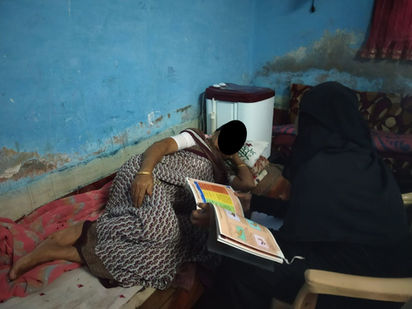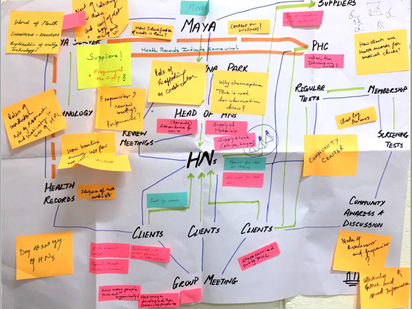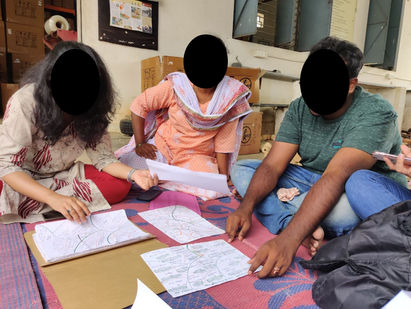Redesigning Maya Health
Design Research Approach
Duration: 2 Weeks
Project Info: Design Research Workshop
My Role: Design Research, System Mapping, Preparing Interviews Questions, Organisation Design, Service Design Blueprint
Project Overview
Problem
As a part of the Design Research workshop, we coordinated with MayaHealth and helped them to make a spin-off of their model. MayaHealth has been actively working on preventive and promotive health practices in rural and semi-urban areas of north Karnataka since 2014. MayaHealth bridge the gap between the healthcare system and community with the help of women as Health Navigators. These Health Navigators introduces services and products in preventive healthcare, initiate collective enterprise model act and mapped and tied with other health care providers. MayaHealth approach is to create dedicated, trained, technology-enabled healthcare micro-entrepreneurs. Currently, there are around 60 Health Navigators actively working in the semi-urban Channapatna town of Karnataka.
Proposed Solution
A new spin-off entity for Maya Healthcare - “Unnati”. The entity is focused on three main objective areas: Strategies for Collectivising & Collaborating, Financial Growth & Entrepreneurial Thinking and Data-Driven Practices of HE’s. The entity is also based on three functional areas: Business and Innovation, Operations and Assessments, Training and Scaffolding. This proposal would be the guiding outline process for the stakeholders in reorganising and restructuring Maya Healthcare and making it more sustainable.
Process
01
Understanding the
Problem Statement
02
Secondary
Research
03
Identifying Functional Areas
04
Primary
Research
05
Defining Objective Areas
Why the need for a new entity?
-
To bring about economic sustainability
-
To bring communal behaviour change
-
Fewer opportunities to scale operations
-
Lack of entrepreneurial spirit and creative energy
-
Lack of motivation and ownership
-
Lack of technical support and infrastructure
-
Lack of traction with governmental bodies
-
Difficult geographical and socio-cultural settings

To build a sustainable health ecosystem of local micro-entrepreneurs who focus on providing high-quality preventive and promotive healthcare service that is acceptable and affordable to the community.
A build a healthy, thriving, self-sufficient and self-reliant network of communities of confident, financially secure women in the health sector, who are community influencers and decision-makers.
• Promote health & wellbeing in a sustainable way
• Evidence-based, Quality, Affordable and Accessible healthcare
• Engage with (& strengthen) Public Health System for greater impact
• Enabling and empowering HEs
• Ethical and Context-Specific
• Non-discrimination across the socio-economic and cultural background
Mission
Vision
Values
Defining Functional Areas
For a new entity, we defined the three functional areas and explored them individually.

Mapping Current System

System Map
Offering Map
Affinity Map
Service Blueprint
Primary Research

Interview with
HN Coordinator
Interview with CEO,
Maya Health
Alex Rodrigues
Interview with
Health Navigators
Clients
Home Visits
HNs examining clients
Interview with HNs

Mapping with HN coordinator
Interview with HNs
Observation
-
HN’s kit is consists of BP and sugar check machines, supplies for the subsequent testing and other health products
-
HNs manually enter the client’s health data in a book for future references
-
Testing is done based on the previous record
-
HNs are financially independent and confident
-
Lack of flexibility in HNs working conditions
-
Examine 5-7 clients in a day. Minimum time taken is 20 minutes
-
Health Camps are organised for awareness in the community
-
HNs have trouble in commuting to client’s house
-
HNs shave Self Help Groups (SHGs) for communication
-
Lack of accessibility to first aid kit and emergency medication
Defining Objective Areas
Information from primary research as well as through secondary research gave us an idea of what updates the new entity would need. We started listing down the areas that are necessary for this new entity and narrowed it down to three main objective areas.
Financial Growth & Entrepreneurial Thinking

Objective
Areas
Financial Growth and Entrepreneurial Thinking gives us the main points out on how to make a whole entity financially more sustainable. The main aspects to look upon are entrepreneurial training, financial management and value propositions.
Strategies for Collectivising & Collaborating
Strategies for collectivising and collaborating help us in navigating the important functions in the entity. The possible areas were looking into are financial opportunities, resources and training.
Data-Driven Practices of HN’s
The data is collected by the HN’s will be used to make strategic decisions and planning which can help in scaling the entity. It helps in structuring the valuable data and provide it to clients and PHC for medical conditions on special request.
New Organization Structure - UNNATI
After synthesizing all the information, we propose a new spin-off entity “Unnati”. The entity will work on three main objective areas: Strategies for Collectivising & Collaborating, Financial Growth & Entrepreneurial Thinking and Data-Driven Practices of HE’s. We also updated the System Mapping of the entity based on the three functional areas: Business and Innovation, Operations and Assessments, Training and Scaffolding. We also defined the Who, How, What and Why of the entity. We represent the road map of the system along with the new organisation structure.

Business
Coordinator
-
Fundraising
-
Industry Collaborations
-
Research Activities
-
Scaffolding Strategies
-
Financial Planning
-
Legal
Training
Coordinator
-
Training Delivery
-
Training Curriculum
-
Periodic Workshops
-
Research Activities
-
HEs Skills Development
Operations
Coordinator
-
Operations
-
Resource Management
-
Assessment
-
Recruitment
-
Technology Support
Health
Coordinator
-
Daily Operations
-
Review Meetings
-
Training
Collective
Health
Entrepreneur
Organisation Structure


The Business and Innovation wing ties up with various collaborators to give the HEs as collective access to a pool of resources that will allow them to further expand their entrepreneurial ventures with the backing that they require. It uses the research from the existing programs to suggest further improvements and scout for the connections to provide the resources that the HEs may require in the near future by reading current trends. It also expands the program to more areas by looking for existing entities that have gained the trust of the community as well as by contextualizing the program to the communities in the area.

The task of the Operations & Assessments unit will be to focus on channelizing the resources among the HEs. It along with the collective will carry out recruitment drives through different medium like campaigning, networking, workshops, 3rd party certifications, etc. It will also look after the new ways to train and assess HEs. It brings new technologies to the entity, connects with different organisations for infrastructural support, looks out for new potential health products, tie-ups with legal and pharmaceutical companies and connects with different communication media. It focuses on the financial operations of the HEs and assists in distributing external funds and profits received by the entity.

In Training and Scaffolding, we would like the entity to offer social, legal and entrepreneurial training during the initial training. The HEs who are now addressed as a part of a collective should be able to choose any additional courses. The mode of education can be classroom or online depending on whether the course is mandatory or voluntary. Giving HEs a choice of material to learn from could help them scaffold and plan their future and also understand their interests. Collectives can collaborate with external entities like government, NGOs and companies through Unnati, to generate mutual benefits.

A road map follows the journey of various functional areas addressing different aspects of objectives.
1. Operations & Assessment: We identified recruitment, training, resources, scaffolding and technology as a few of the important aspects that operations and assessment need to address to achieve the objectives discussed. The map plots the journey in each aspect with rest to collective an Unnati.
2. Training & Scaffolding: Training, Scaffolding and Research are identified and the journey of collective & Unnati was plotted across these aspects to achieve the objectives.
3. Business & Innovation: Research, Legal, Scaffolding, Resources and Recruitment were identified. Here, the journey was plotted for Unnati & External Entities which would influence the objectives.
Team: Animesh Bondre, Anshul Jain, Archit Sharda, Devyani Adhikari, Jerusha Youtham,
Mrunali Ogriwala, Priyavadanaa J, Rajath TS, Ravi Chug & Sanjana Kothapalli





